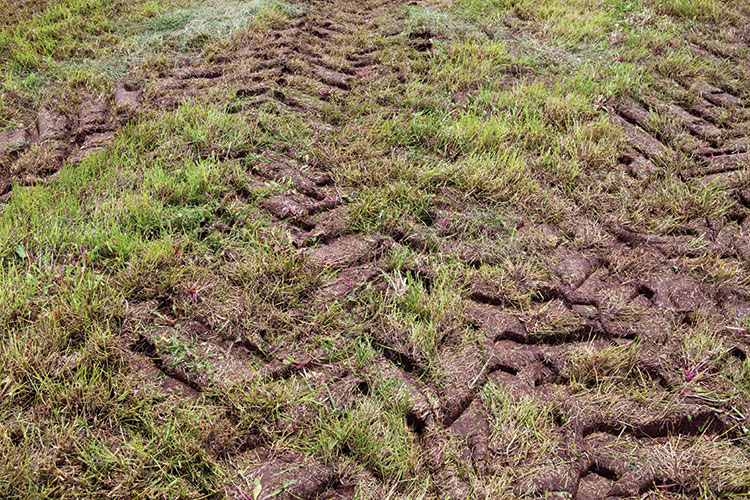Soil compaction means increasing soil density that makes working with soil easy, helps in erecting stable structures, and reduces maintenance costs. Read to learn about the desirable, and undesirable, effects of mechanical soil compaction on construction and agricultural works.
Compaction of soil brings stability and strength with it. Foundations fail most commonly because of improper compaction methods or poorly compacted soil that allows water to seep through the foundation and cause structural damage. Implementing mechanical methods to compact soil means densifying the soil, filling the pore spaces, improving the shear resistance of soil, and providing better water movement through the soil particles. The compaction process largely depends upon the type of soil you are dealing with because different soils have different physical properties and accordingly different compaction methods should be adopted. Compaction also prevents frost damage of soil and increases its durability.
Factors Affecting the Compaction Process

Compaction of soil depends upon various factors. Among them, grain size distribution of soil, optimum moisture content, maximum dry density, layer thickness, and environmental factors are some of the important things to consider. Optimum moisture content (OMC) is the percentage of water present in soil mass at which a specific compaction force can dry the soil mass to its maximum dry weight. The adjacent graph (please click to enlarge) shows that the void ratio at OMC is approximately zero and soil is densely compacted. For different types of soils, OMC and maximum dry density curves are different.
In the figure, W stands for water content and ρ(d) stands for Dry Density of soil mass.
Standard Proctor and Modified Proctor tests are conducted to determine OMC and the dry density of soil masses. The basic difference between these two tests is the size and weight of hammer used to compact the soil mass. The number of blows remains the same, but the falling height is changed from 12 inches to 18 inches in the Modified Proctor test. Other popular methods of determining OMC and maximum dry density are mentioned below.
Sand Cone Test – Suitable for a large sample, delivers accurate results but requires huge area and more time to perform.
Shelby Tube Test – Suitable for deep and under pipe haunches, not suitable for gravels and only works for a small sample.
Nuclear Gauge Test – Statistically reliable, easy to redo and fast method.
Compaction of soil, in simple words, means applying external pressure to the soil mass so that its characteristic properties improve with regard to construction purposes. Technically speaking, static and vibratory forces bring soil particles together by exerting pressure on them. Static forces apply load on the surface of soil particles, exerting dead weight of the machine in a downward direction. These forces do not go skin deep and work only for the upper surface of the soil mass.
Vibratory forces, on the other hand, work for the whole soil mass and are not limited to the upper surface only. Along with the dead-weight of machine, compactors and vibrators are connected that not only exert pressure on the soil mass, but also shuffle the entire soil mass so that the overall soil mass is compacted uniformly. Both the top and deeper layers get blows from the vibrator and compactor resulting in denser and tightly packed soil.
For mechanical soil compaction, four main compaction techniques are mentioned here.
Kneading Compaction
Pressure Compaction
Vibration Compaction
Impact Compaction
Compaction equipment is selected based on the type of soil. For clayey soils, kneading techniques and equipment have to be used because clay soils exist in the form of clods and kneading is the best way to break the clods and densify clay soils. On the other hand, for granular soils, a vibratory or shaking motion of the compacting device is required so that uniform compaction is achieved. Popular compaction equipment types are mentioned below.
Smooth Wheel Rollers – Single axle, equipped with a steel cylinder, sand or water are used to increase its self-weight. Pushes the soil in the direction of movement and results in soil compaction.
Sheep Foot Roller – Different style of sheep rollers, can be used for different types of soil, best suited for cohesive soils. Covers less surface area but pressure per unit area is very high resulting in healthy compaction.
Vibratory Drum Roller – Suitable for compaction of sand, gravel, asphalt, and other heavy aggregates.Very powerful compaction devices, provide uniformly dense soil because of vibrator attached to them.
Vibratory Padfoot Compactors – Compactors work mainly in landfill regions and padfoot compactors have pads attached to their drums making them work fast and deliver efficient results in confined and tight areas.
Tamping Foot Rollers – Basically, these devices are compactors but are popularly known as tamping foot rollers. Kneading, impact compaction and pressure compaction happen simultaneously with these devices.
Different classification systems divide soils according to their characteristic properties and accordingly compaction method is selected.
Image: Virbratory Dynapac

Agricultural Aspects of Compaction
Soil compaction is equally important for agricultural works. However, soil compaction has certain disadvantages associated with it for agricultural activities. If the natural soil structure is disturbed by compaction, by natural or artificial methods, the soil’s ability to produce a good yield decreases considerably. Compaction, as we have seen in case of engineering works, affects soil porosity, natural air and water flow through the soil, and curbs root penetration of soil, which acts in an otherwise manner for crops. To avoid compaction of agricultural soil and to avoid any heavy damage to the natural structure of the soil, the following tips should be observed:
Field operations on wet soil can be dangerous and may inflict permanent damage to soil structure, so avoid working on wet soil.
Ensure proper weight distribution for tillage operations, avoid using very heavy rollers because you might be killing your land in the name of saving time.
Address drainage problems and use conventional tillage methods to remove existing compaction.
Organic farming is a great way to increase soil strength and avoid compaction.


